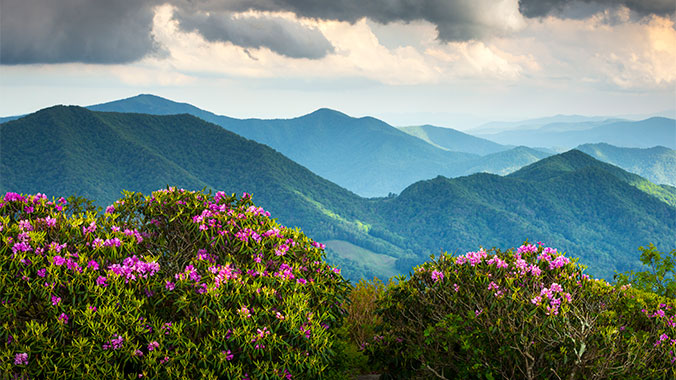With breathtaking mountains, valleys, forests, rivers, and streams, it’s not surprising that the Blue Ridge Mountains attract nature lovers from around the globe. For North Carolinians, the mountain range offers much more than natural beauty. Officially recognized by Congress, North Carolina’s Blue Ridge Mountain National Heritage Area offers a rich legacy in the music, art, and traditions of Native Americans and European settlers. The many attractions and charms of this mountain region are set against a stunning backdrop of natural beauty.
The Blue Ridge Heritage Trail
The Blue Ridge Heritage Trail spotlights natural and cultural heritage sights within the Blue Ridge National Heritage Area’s 27 counties, using signs and interactive kiosks that tell stories about each one. Here, road trippers can learn about the region’s agricultural, Cherokee, craft, and traditional music heritages. The Blue Ridge Parkway extends for 252 miles through the trail, from Cherokee, North Carolina to the Virginia border. Stops along the parkway include the Folk Art Center at Milepost 382, and Doughton Park, where travelers can see local craft demonstrations.
The Blue Ridge Music Trails
The Blue Ridge Music Trails spotlight the region’s traditional music, from bluegrass to rhythm and blues and country, suggesting day trips to historic cities such as Black Mountain near Asheville, West Jefferson, and Mount Airy, home to the annual Mount Airy Bluegrass and Old Time Fiddlers convention. Itineraries also spotlight African-American music trails that feature styles such as jazz, gospel, and blues.

Cherokee Heritage and Culture
Tucked between the Blue Ridge Mountains and the Smoky Mountains, Cherokee, North Carolina is home to the Cherokee Welcome Center and the Museum of the Cherokee Indian, which showcases artifacts, interactive videos, and displays that chronicle the 11,000-year history and culture of the Cherokee nation. A 20-foot-tall hand-carved statue of Sequoyah, who invented the Cherokee alphabet, stands at the museum’s entrance.
Road trippers can visit Oconaluftee Indian Village in Cherokee — a recreation of an 18th century Cherokee village — and view demonstrations of traditional Cherokee dances, canoe hulling, and blowguns. Buy authentic Cherokee pieces such as masks, pottery, and beadwork at Qualla Arts and Crafts Mutual, Inc. Cherokee heritage and culture can be further explored within seven Cherokee Heritage Trails in the region.

Small Town Charms and History
North Carolina’s Blue Ridge Mountains are dotted with small towns that effuse history and charm, such as Brevard, known for its waterfalls, festivals, and music scene. The Brevard Music Center draws nationally acclaimed performers, such as Steve Martin, for performances and jam sessions of everything from classical music to serious banjo-playing.
Six miles from Asheville, Weaverville has a history of grand hotels, such as the Dula Springs, where visitors like short story author O. Henry stayed during the 19th century to take advantage of the area’s benefits to their health and well-being. Today, travelers can stay in B&Bs and country inns, including the Inn on Main Street in Weaverville and Asheville’s Sweet Biscuit Inn.
Farming fans can stop in Forest City to see the antique tractors and other relics of farm life at the Rutherford County Farm Museum and to shop for fresh local produce such as squash, corn, peaches, and blueberries at the Farmer’s Fresh Tailgate Market. In 1927, the U.S. Department of Agriculture named Forest City as one of the 10 best-planned and attractive towns in the nation.
Have you explored the rich culture and history of Blue Ridge Mountain National Heritage Area firsthand? Share your favorite spots and experiences with me in a comment.

Leave a Reply